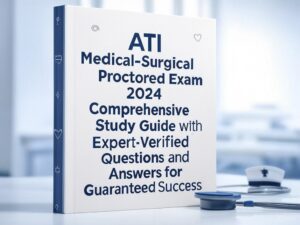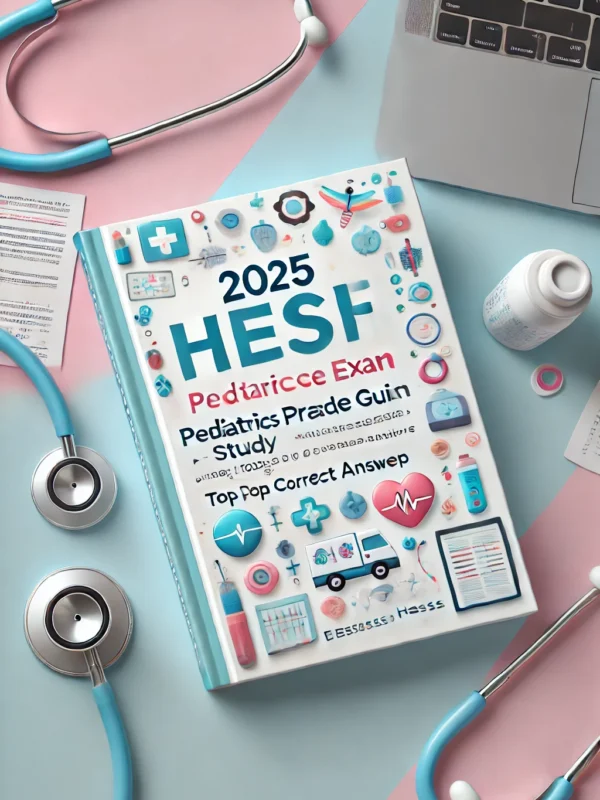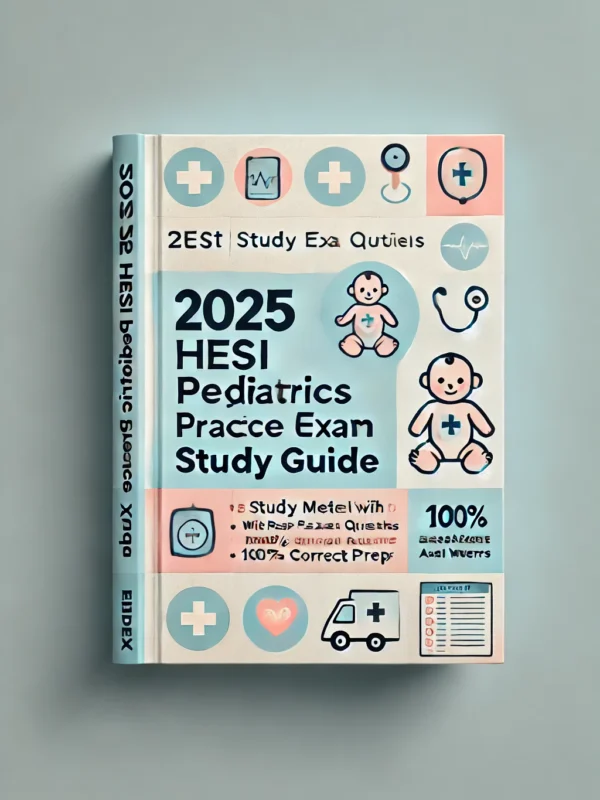Ensure success in the ATI Medical-Surgical Proctored Exam 2024 with this comprehensive study guide, meticulously designed for nursing students aiming for guaranteed results. This guide features expert-verified questions and answers that span critical medical-surgical nursing topics, including cardiovascular, respiratory, gastrointestinal, endocrine, and neurological disorders, as well as perioperative care and emergency nursing. Each question is accompanied by detailed, expert-validated explanations to solidify understanding of complex concepts and enhance clinical reasoning skills. Aligned with the 2024 ATI Med-Surg content outline, this resource integrates the latest evidence-based practices and NCLEX-style questions to provide thorough preparation. Perfect for nursing students seeking to excel in their med-surg coursework and proctored exams, this study guide is a reliable tool for achieving academic excellence and professional readiness.
Preview
1. A nurse is planning care for a client who has full-thickness burns on the lower
extremities. Which of the following interventions should the nurse include?
a) Limit visitation time for client’s children to 40 minutes per day
b) Clean the equipment in the client’s room once per week
c) Provide a diet of fresh fruits and vegetables for the client
d) Apply new gloves when alternating between wound care sites (Correct Answer: d)
Rationale: Infection control is critical for burn patients. Changing gloves between wound
sites prevents cross-contamination and reduces the risk of infection.
2. A nurse is caring for a client who has cancer. The client tells the nurse, “I would
prefer to try vitamins and minerals instead of chemotherapy.” Which of the following
responses should the nurse make?
a) “I have never heard of any holistic treatment that is effective.”
b) “You should ask your provider about your plan.”
c) “The best way to treat your cancer is chemotherapy.”
d) “Tell me what you know about chemotherapy.” (Correct Answer: d)
Rationale: This response encourages open communication and assesses the client’s
knowledge, allowing the nurse to provide appropriate education and support.
3. A nurse is planning to teach a client whose provider has prescribed a low-purine
diet. The nurse should plan to instruct the client that they can include which of the
following foods in their diet? (Select all that apply)
a) Sardines
b) Nuts (Correct Answer)
c) Apricots (Correct Answer)
d) Liver
e) Scallops
Rationale: Sardines, liver, and scallops are high in purines and should be avoided by
clients with conditions like gout. Nuts and apricots are low-purine foods and are safe to
consume.
4. A nurse is caring for a client following a total knee arthroplasty. The client reports a
pain level of 6 on a pain scale of 0 to 10. Which of the following interventions should
the nurse take?
a) Place pillows under the client’s knee
b) Gently massage the area around the client’s incision
c) Apply an ice pack to the client’s knee (Correct Answer)
d) Perform range-of-motion exercises to the client’s knee
Rationale: Applying ice reduces inflammation and provides pain relief. Placing pillows
under the knee could promote contractures, and massaging near the incision may cause
discomfort.
extremities. Which of the following interventions should the nurse include?
a) Limit visitation time for client’s children to 40 minutes per day
b) Clean the equipment in the client’s room once per week
c) Provide a diet of fresh fruits and vegetables for the client
d) Apply new gloves when alternating between wound care sites (Correct Answer: d)
Rationale: Infection control is critical for burn patients. Changing gloves between wound
sites prevents cross-contamination and reduces the risk of infection.
2. A nurse is caring for a client who has cancer. The client tells the nurse, “I would
prefer to try vitamins and minerals instead of chemotherapy.” Which of the following
responses should the nurse make?
a) “I have never heard of any holistic treatment that is effective.”
b) “You should ask your provider about your plan.”
c) “The best way to treat your cancer is chemotherapy.”
d) “Tell me what you know about chemotherapy.” (Correct Answer: d)
Rationale: This response encourages open communication and assesses the client’s
knowledge, allowing the nurse to provide appropriate education and support.
3. A nurse is planning to teach a client whose provider has prescribed a low-purine
diet. The nurse should plan to instruct the client that they can include which of the
following foods in their diet? (Select all that apply)
a) Sardines
b) Nuts (Correct Answer)
c) Apricots (Correct Answer)
d) Liver
e) Scallops
Rationale: Sardines, liver, and scallops are high in purines and should be avoided by
clients with conditions like gout. Nuts and apricots are low-purine foods and are safe to
consume.
4. A nurse is caring for a client following a total knee arthroplasty. The client reports a
pain level of 6 on a pain scale of 0 to 10. Which of the following interventions should
the nurse take?
a) Place pillows under the client’s knee
b) Gently massage the area around the client’s incision
c) Apply an ice pack to the client’s knee (Correct Answer)
d) Perform range-of-motion exercises to the client’s knee
Rationale: Applying ice reduces inflammation and provides pain relief. Placing pillows
under the knee could promote contractures, and massaging near the incision may cause
discomfort.












Reviews
There are no reviews yet.